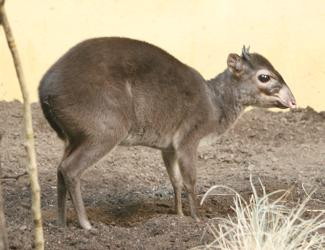Poachers are usually less active in places where they are more likely to be caught, which is why the presence of ecotourists and ranger patrols is known to benefit protected wildlife by reducing trespassing. However, many parks and preserves also have another type of potential guardian--scientific and conservation researchers. Until recently, the potential direct conservation benefits of scientists was unknown, but a new paper reports that the presence of field researchers helps turn their long-term study sites into "refugia" for local wildlife.
(Red colobus monkey, Procolobus badius)
(Diana Monkey, Cercopithecus diana)
(Maxwell's duiker, Philantomba maxwellii)
While conducting population surveys, the researchers also searched for signs of poaching, including trails, camps, snares, and empty cartridges. These data had two purposes. First, they were used to generate park-wide maps comparing the amount poaching activity with densities of red colobus monkeys. Second, they were included in statistical analyses investigating whether poaching activity decreased with proximity to the long-term research sites within the national park. The analyses also investigated whether numbers of all duikers, all primates, and the three focal species increased with increasing proximity to the long-term study area.
The results of the analyses were striking. In the maps, moderate to high densities of red colobus monkeys could be seen within the long-term study site, but almost no signs of poaching were found within, or in a band of habitat around, the study area. This same pattern is reflected in the results of the statistical analyses, which showed that numbers of duikers, primates, and all three overharvested species significantly increased with increasing proximity to research area, while visible evidence of poaching significantly decreased.
(Hikers in the Taï National Park, Côte d’Ivoire)
Such positive impacts will probably only be observed in locations where biological research is sustained over a long period of time--once the scientists leave, there is nothing to stop trespassers from wreaking havoc. This was recently observed at the Marahoué National Park, where 93% of forest cover was lost after the departure of a conservation organization. Given that long-term researchers can gather informative datasets about behavior, life history, ecology, and evolution (among other things) while also performing a conservation role, it seems that their research funding is more than justified--something that might be worth mentioning in future grant proposals.
---
Campbell, G., Kuehl, H., Diarrassouba, A., N'Goran, P.K., and Boesch, C. 2011. Long-term research sites as refugia for threatened and over-harvested species. Biology Letters 7:723-726.
Thanks to the following websites for providing the images used in this post:
http://en.wikipedia.org/wiki/File:Diana_Monkey.jpg
http://www.stanford.edu/~siegelr/tz/zanzibar2007pix.html
http://en.wikipedia.org/wiki/File:Stavenn_Cephalophus_maxwellii.jpg
http://www.virtualtourist.com/travel/Africa/Cote_DIvoire/Off_the_Beaten_Path-Cote_DIvoire-TG-C-1.html




No comments:
Post a Comment